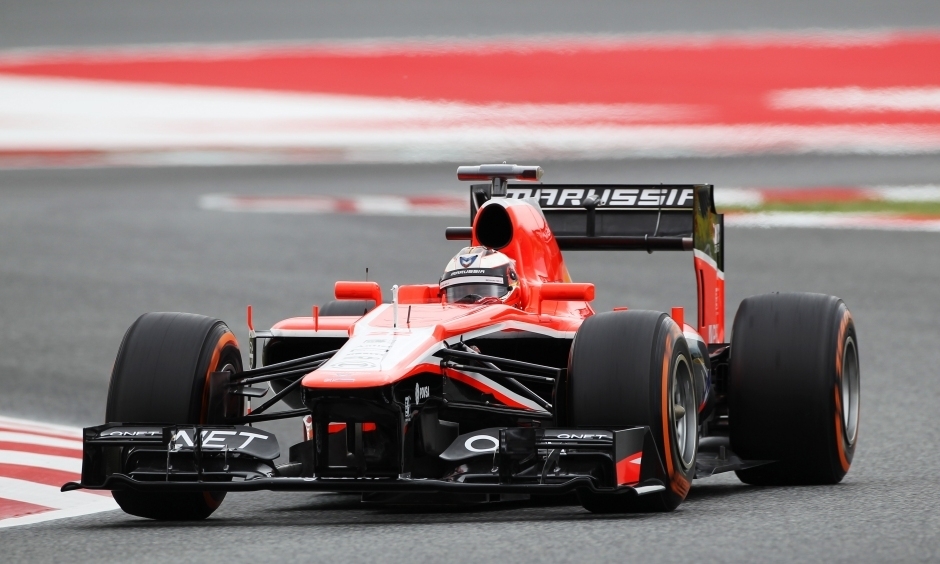
An Unwelcome Guest Returns to Formula One
Jules Bianchi in his Marussia formula F1 car.
This month, after a 21-year hiatus, an unwelcome guest returned to Formula One racing.

At the rain-soaked 2014 Japanese Grand Prix on Sunday, October 5, Marussia F1 driver, 25-year-old Jules Bianchi, a native of Nice, France, lost control of his car and slammed into the back of an industrial mobile crane that was removing the crashed Sauber car that German driver Adrian Sutil had walked away from on the previous lap. Bianchi’s Marussia rounded Dunlop curve and hit the back of the crane at close to 100 miles per hour, generating enough impact force to temporarily make the crane leap into the air and off the edge of the soggy track. Bianchi suffered a severe traumatic brain injury known as diffuse axonal injury which had left him in a coma since the October 5 crash. On July 17 of this year, some nine months later, Bianchi succumbed to his injuries.
Bianchi’s death marks the first death in Formula One since the infamous 1994 season, a season that was particularly dangerous due to mandated changes in the Formula One rules which eliminated the use of drivers’ aids such as ABS (anti-locking brakes), adaptive suspensions and traction control, to name but a few, in an effort to increase competition amongst drivers. The intent was to emphasize driver skills and eliminate what was widely perceived as an unhealthy reliance on technical aids that were supposedly making the cars easier to drive and therefore limiting competition among the drivers themselves. When it came to technology, the less is more approach to racing in the 1994 season would prove fatal, claiming the lives of two drivers: Austrian rookie Roland Ratzenberger and three-time Formula One world champion Ayrton Senna, both of whom were killed in high speed crashes that occurred only one day apart at the 1994 San Marino Grand Prix in Imola, Italy. Ratzenberger’s crash took place on qualifying day, Saturday, April 30, whereas Senna’s occurred the following day during the Grand Prix itself.

Unlike Bianchi’s collision, both of the fatal crashes in 1994 occurred in dry conditions. During qualifying for what would have been his second ever Grand Prix race, the damaged front wing on Ratzenberger’s Simtek car broke off, leaving the car uncontrollable due to a lack of sufficient downforce and causing it to careen into a wall at a blistering 196 miles per hour. The very next day, Senna climbed into his Williams car for the last time. Tucked into the cockpit of Senna’s car was an Austrian flag that he planned on waving during his victory lap as a sportsmanly form of honoring the recently departed Ratzenberger. That opportunity never came.
On the seventh lap of the San Marino Grand Prix, Senna slammed into a wall at approximately 135 miles per hour and fell victim to a fatal combination of circumstance. The sheer force of the impact itself had thrust one of the Williams’ front wheels into the cockpit, violently forcing Senna’s head back into the headrest and fracturing his skull, and the front suspension had broken apart on the crash sending shrapnel through the visor of his helmet. By the time he was extracted from the mangled car, Senna had lost all brain activity. By that evening he was dead.
In the immediate aftermath of the deadly 1994 San Marino Grand Prix, rigorous new safety requirements were introduced. The back to basics approach of the 1994 season (concerning technology and, more specifically, drivers’ aids) was quickly jettisoned. Subsequent seasons would once again embrace technology in the name of both safety and speed. Consequently, in the two decades since 1994, Formula One racing has become a substantially safer and faster sport. But, as Jules Bianchi’s recent accident in Japan reminds us, no matter how technologically advanced the cars may now be and no matter how skilled the athletes who drive them may be, risk cannot be eliminated completely. With this in mind, death, the unwelcome guest, returns to Formula One racing. Perhaps the iconic lost-generation writer F. Scott Fitzgerald was right when he ended The Great Gatsby by stating that, “So we beat on, boats against the current, borne back ceaselessly into the past.”













